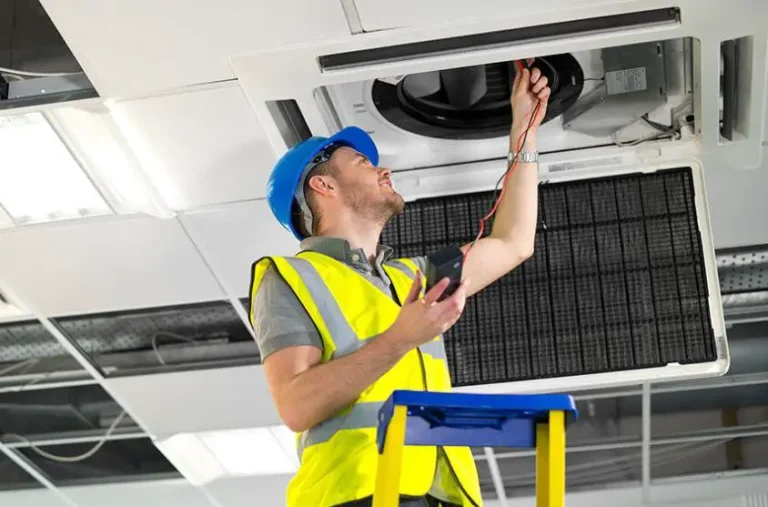Duct access doors provide safe and efficient entry points into ductwork, allowing for inspections, cleaning, and repairs without major disruption. The result is a well-functioning HVAC system that supports energy efficiency, improves indoor air quality, and complies with building regulations.
The complex network of ducts and components, from dampers to coils, often makes servicing these systems challenging, especially without proper, dedicated access. They turn maintenance into a difficult and costly chore.
Solutions like duct access doors make maintenance easy, ensuring the HVAC equipment lasts longer.
This blog post will explain why these access solutions are not just convenient but necessary.
What Are Duct Access Doors?
Duct access doors are sealed panels or hinged doors installed into the walls of an HVAC duct system to provide a secure and easy way to get inside. Their main purpose is to let technicians access the ductwork’s interior for maintenance without taking the system apart.
These doors come in different types, each designed for a specific job.
- Standard duct access doors are used for general HVAC systems in places like offices or stores.
- Grease duct access doors are a special requirement for commercial kitchens and food facilities.
- Duct access doors can also be insulated or uninsulated, depending on the duct’s temperature needs.
- They come with various locks, from simple screw-on panels to secure hinged doors with cam locks.
Duct access solutions are placed in key spots within the ductwork, such as near coils, dampers, fans, and bends, to ensure every important component is within reach for routine service.
Why Do Commercial Buildings Rely on Duct Access Doors?
Commercial buildings rely on duct access doors because these doors are the foundation of a proactive maintenance plan. They offer convenient accessibility that makes HVAC service simple and professional.
In a large building, getting to the components inside a vast duct network can be the biggest obstacle to effective maintenance. Without these specific access points, technicians would have to cut into the ductwork, do the service, and then patch the duct back up.
This process is tedious and expensive, and it weakens the system over time. Such disruptions are unacceptable for busy places like hospitals, restaurants, and office complexes, where uninterrupted operation is crucial.
A restaurant, for instance, can’t afford to shut down for a few days just to have its kitchen exhaust system cleaned.
What Are the Key Benefits of Installing Duct Access Doors?
Installing duct access doors brings many benefits, from preventive maintenance and energy efficiency to compliance and cost savings.
Easier Preventive Maintenance
Duct access doors allow regular, scheduled cleaning of coils, dampers, fans, and the duct interior. Scheduled cleaning stops dirt and grime from building up and blocking airflow.
Preventive maintenance reduces the time and effort needed for routine checks by making these parts easy to get to. This proactive strategy helps catch small issues before they become big problems.
For example, a quick check through an access door can show a misaligned damper or a dirty coil, allowing for an immediate fix that prevents long-term wear and tear on expensive equipment.
Energy Efficiency and Indoor Air Quality
Installing duct access doors supports a building’s energy efficiency and indoor air quality in a few ways. First, regular cleaning ensures efficiency since clean ducts are the basis of a healthy HVAC system.
By making cleaning easy, duct access doors ensure that airflow remains open, allowing the system to run at its best. When dust, mold, or grease builds up inside ducts, it restricts airflow, forcing the HVAC system to work harder to move air throughout the building. This extra strain leads to higher energy use and bigger utility bills.
Second, clean ducts prevent the spread of airborne particles like mold spores, allergens, and dust. They ensure a healthy indoor space, especially in hospitals, schools, and offices, where people’s health is a top concern.
Code Compliance
Mechanical compliance codes like the IMC, or NFPA 80, require specific duct doors for areas like fire dampers. Fire dampers are an important part of a building’s fire safety system, and as such, easy access to maintain them is required by code.
This makes duct access doors an important part of enhancing fire performance and meeting strict building and fire codes.
Another example is grease duct access doors in commercial kitchens. Grease buildup in exhaust ducts is a serious fire risk.
These specialized, fire-rated duct doors are required for fire performance and compliance with standards such as NFPA 96. They are built to handle high temperatures and provide a secure, fire-rated seal. They allow for regular cleaning of grease-filled ducts, which is a key requirement for preventing kitchen fires.
Cost Savings and Reduced Downtime
The initial cost of duct access doors provides significant long-term savings by lowering labor costs and operational downtime.
When a system needs a repair, a technician with easy access can find and fix the problem much faster than one who has to spend hours taking apart and putting the ductwork back together. This efficiency leads to lower labor costs.
In a commercial setting, every moment of downtime is a lost opportunity. A broken HVAC system can disrupt business, cause a drop in productivity, or even force a temporary closure.
By making quick repairs and consistent preventive maintenance possible, access doors lower the risk of unexpected breakdowns, ensuring businesses keep running smoothly.
Ultimately, the consistent cleaning and maintenance made possible by these doors also extends the life of expensive HVAC equipment. The result is a delayed need for costly replacements and a greater return on your investment.
How Do You Choose the Right Duct Access Door for Your Building?
Consider placement, insulation, size, material, code compliance and more when choosing the right duct access door for your building.
- Placement: Understand the specific environment where the duct is located. A standard office building, a hospital, and a commercial kitchen have different needs.
- Insulation: An insulated access door is necessary if the duct carries conditioned air. The insulation prevents heat loss or gain, which helps maintain the system’s energy efficiency and prevents condensation on the duct’s exterior, which could lead to mold growth.
- Size: The door must be large enough to allow a technician to comfortably and safely access the component it is intended to service. Most manufacturers provide access door customization options for non-standard measurements.
- Material: The material must match the duct’s contents and the surrounding environment. Galvanized steel or aluminum is fine for standard air ducts. Stainless steel is the industry standard for grease ducts due to its corrosion resistance and fire rating, as well as for pharmaceutical or clean room applications for sanitary standards.
- Seals and Gaskets: Ensure the access door is properly sealed to the ductwork. For standard ducts, this prevents air leakage that would waste energy. For grease ducts, it prevents leaks of flammable grease.
- Code Compliance: Choose access doors that meet local building codes, NFPA standards, and other regulations where necessary.
Conclusion
Installing duct access doors in commercial buildings provides accessibility, leading to greater safety, better efficiency, and consistent compliance. They are not a luxury but a fundamental part of a modern HVAC system, turning complex duct maintenance into a simple process.
They enable preventive maintenance that makes equipment last longer, saving costs in the long term. Specialized duct doors help meet fire codes in commercial kitchens. These simple access solutions are a proactive step that ensures your most important mechanical system runs at its best, year after year.













